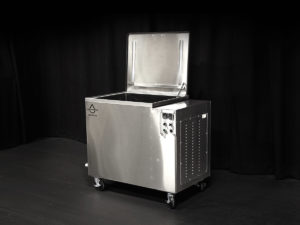If we expect our ultrasonic cleaners to perform as designed and last for years to come, there are a number of things you should and shouldn’t do to keep them running efficiently. Just as important is your personal safety as you work around and with your ultrasonic cleaning systems—there are some things you should always take the time to do, and some things you should never do to keep yourself and your employees safe. Here is a list of some of the major dos and don’ts as they relate to the longevity of ultrasonic cleaners.
The Dos
To keep our ultrasonic cleaner performing at top-notch speed, and to keep ourselves safe in the process, we should:
- Always unplug the unit before draining the solution. Leaving the heating elements energized by accident can cause them to overheat and fail. Also, water and electricity don’t mix, and the combination can be lethal when the human body is involved with excess splashing.
- Drain the detergent and clean out the tank occasionally. The heavier gunk and dirt that falls off the parts cleaned will settle at the bottom of the tank and may not filter through the filtration system. This debris takes up space in the bath and dampens the ultrasonic waves, which makes cleaning less effective. Use a rag and wipe the tank bottom clean, or rinse it with clean, cool water.
- Change the filtration system’s filters regularly. Ultrasonic cleaners will remove everything from the part’s surface that shouldn’t be there, and much of that will float in the detergent and be removed by the filtration system. Changing the filters regularly keeps contaminants out of the cleaning detergent, helping the system do its job better and faster.
- Use water-based detergents. Solvent-based cleaners are generally not designed for use in an ultrasonic cleaner, and may damage the stainless tank surface in some instances. Solvents with low flash points – below 200˚F, are never recommended. Plus solvents are unhealthy for humans.
- Wipe or spray down parts that have heavy, greasy or loose contamination before placing them in the ultrasonic cleaner if possible. The cleaner will remove all the dirt no matter how badly it is caked on, but as we mentioned above, the dirt that comes off must go somewhere, and that “somewhere” will either be the filters or tank bottom, which adds to our maintenance frequency.
- De-gas new detergent before you begin cleaning parts. Fresh solution will have some gasses—mostly air—trapped in it, and if these dissolved gasses aren’t removed, it will take the parts longer to get clean while the detergent degasses itself. Degassing is as simple as raising the temperature on the unit to the desired temperature, and operating the cleaner without anything else in it for a short period of time – ten minutes.
The Don’ts
To avoid damaging your cleaners (and your bodies), you should:
- Never mess with the electronic controls, transformer, or transducers on the unit, or try to do your own repairs. Ultrasonic cleaners operate under high voltage, and if you don’t know what you’re doing, you can damage the equipment and yourself. On a similar note, don’t spray down the outside of the tank, control box, or electrical box with water or other liquids. If the outside gets dirty, unplug the unit and wipe it down with a clean rag.
- Never fill the tank of an ultrasonic cleaner with alcohol, gasoline, or any other flammable liquids. They will vaporize, and could cause a fire or explosion, or release harmful gasses into the workspace.
- Never put any parts of your body into the ultrasonic cleaner while it is operating without proper protection such as thermal gloves and goggles. The detergents can cause mild skin irritation, and the cleaning action can cause discomfort. In addition, the operating temperature of the solution and tank can reach 160 degrees F, which will cause burns.
- Avoid putting chlorine bleach into the tank. Bleach does not promote good cavitation activity.
- Keep parts off the bottom of the tank. Setting parts directly on the tank bottom bottom increases the incident of cavitation erosion – pitting of the tank eventually causing the ultrasonic cleaner to leak . Use a basket, tray, or suspension system to hold parts in the unit.
Now that you have a list of basic dos and don’ts for using, maintaining, and working safely around our ultrasonic cleaners, start cleaning! Following these tips will keep you and your equipment around and working efficiently for a long time to come.

For more information on ultrasonic cleaners visit the Omegasonics website. You can also find us on LinkedIn and Twitter.


